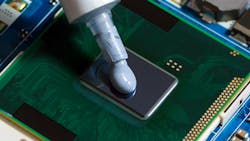Thermal Interface Materials: Cool Options for Better Power Density (Download)
One of the most important—and difficult—design decisions for circuit designers is creating an optimum heatsink method for high-power devices/systems such as power processors and power supplies. A key area of expertise is the attachment method of an electronic power device to a heatsink or a heat spreader. As power densities increase in power electronics, the thermal interface in between the power module/device and heatsink is now a bigger challenge for designers.
The bottom line is to have a solid thermal contact that will direct most of the heat away from the electronic power devices and on through a heatsink.
